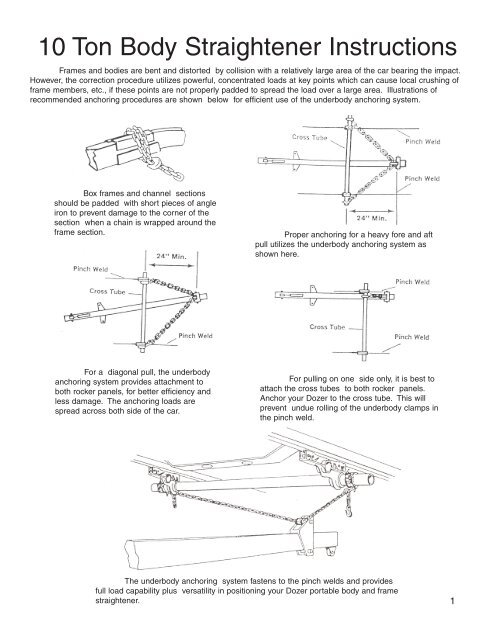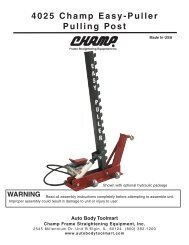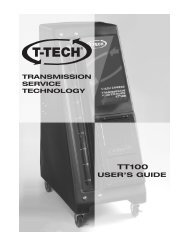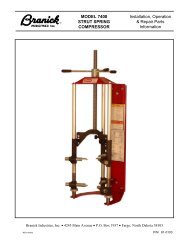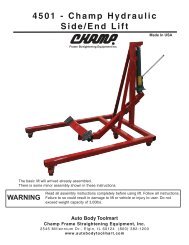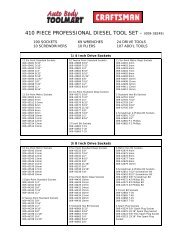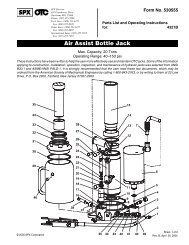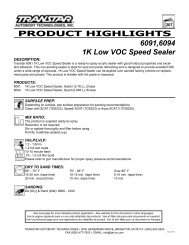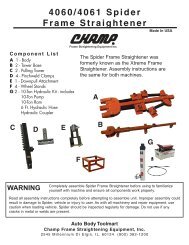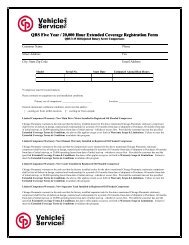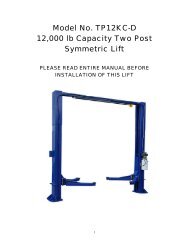download the 10-Ton Body Straightener - Auto Body Toolmart
download the 10-Ton Body Straightener - Auto Body Toolmart
download the 10-Ton Body Straightener - Auto Body Toolmart
Create successful ePaper yourself
Turn your PDF publications into a flip-book with our unique Google optimized e-Paper software.
<strong>10</strong> <strong>Ton</strong> <strong>Body</strong> <strong>Straightener</strong> Instructions<br />
Frames and bodies are bent and distorted by collision with a relatively large area of <strong>the</strong> car bearing <strong>the</strong> impact.<br />
However, <strong>the</strong> correction procedure utilizes powerful, concentrated loads at key points which can cause local crushing of<br />
frame members, etc., if <strong>the</strong>se points are not properly padded to spread <strong>the</strong> load over a large area. Illustrations of<br />
recommended anchoring procedures are shown below for efficient use of <strong>the</strong> underbody anchoring system.<br />
Box frames and channel sections<br />
should be padded with short pieces of angle<br />
iron to prevent damage to <strong>the</strong> corner of <strong>the</strong><br />
section when a chain is wrapped around <strong>the</strong><br />
frame section.<br />
For a diagonal pull, <strong>the</strong> underbody<br />
anchoring system provides attachment to<br />
both rocker panels, for better efficiency and<br />
less damage. The anchoring loads are<br />
spread across both side of <strong>the</strong> car.<br />
Proper anchoring for a heavy fore and aft<br />
pull utilizes <strong>the</strong> underbody anchoring system as<br />
shown here.<br />
For pulling on one side only, it is best to<br />
attach <strong>the</strong> cross tubes to both rocker panels.<br />
Anchor your Dozer to <strong>the</strong> cross tube. This will<br />
prevent undue rolling of <strong>the</strong> underbody clamps in<br />
<strong>the</strong> pinch weld.<br />
The underbody anchoring system fastens to <strong>the</strong> pinch welds and provides<br />
full load capability plus versatility in positioning your Dozer portable body and frame<br />
straightener. 1
Use These Basic Hook-Ups for Correction...<br />
Hook-Up for Sag or Kick-Up<br />
With <strong>the</strong> car firmly supported on safety stands,<br />
place your Dozer under <strong>the</strong> frame rail to be corrected.<br />
Anchor <strong>the</strong> end of <strong>the</strong> Dozer beam to <strong>the</strong> frame rail at<br />
rear of passenger compartment or use <strong>the</strong> underbody<br />
clamps and fasten to <strong>the</strong> pinch weld, Anchor <strong>the</strong> frame<br />
horn to <strong>the</strong> Dozer beam at <strong>the</strong> front. Place a hand jack<br />
or Porto-Power unit on <strong>the</strong> Dozer beam under <strong>the</strong> low<br />
area to raise it.<br />
Hook-Up for Center Sway<br />
Hook-Up for Mash<br />
This basically is a pulling and stretching operation. With<br />
<strong>the</strong> car firmly supported on safety stands, place your<br />
Dozer under <strong>the</strong> frame rail to be corrected. Anchor <strong>the</strong><br />
Dozer to <strong>the</strong> frame or <strong>the</strong> pinch weld with underbody<br />
clamps. Use a frame horn pull plate or clamp on <strong>the</strong><br />
front rail and pull <strong>the</strong> frame straight forward. The inner<br />
pan may be pulled at <strong>the</strong> same time you pull <strong>the</strong> rail.<br />
Hook-Up for Mash with Sag<br />
Attach <strong>the</strong> anchor post of your Dozer to <strong>the</strong> underside of<br />
<strong>the</strong> car, near <strong>the</strong> rear wheels, using chain or <strong>the</strong> underbody<br />
anchoring system. Place a block or jack between <strong>the</strong><br />
Dozer beam and cowl. Chain <strong>the</strong> front of <strong>the</strong> frame horn<br />
to <strong>the</strong> Dozer pivot arm so that you pull <strong>the</strong> frame horn<br />
forward and downward simultaneously.<br />
The above illustration shows a common hook-up to remove center sway from a ladder frame. This same arrangement<br />
can be used for o<strong>the</strong>r types of frames, but <strong>the</strong> frame side rails should be tied toge<strong>the</strong>r by chain in order to move both<br />
rails at <strong>the</strong> same rate. The underbody anchoring system can be used for unitized construction by placing one set near<br />
<strong>the</strong> cowl and ano<strong>the</strong>r set near <strong>the</strong> rear extremity of <strong>the</strong> rocker panels. The car should be well supported, on safety<br />
stands and cross-tubes. When attaching to <strong>the</strong> frame with chain, <strong>the</strong> frame should be protected by <strong>the</strong> use of short<br />
pieces of angle iron to pad <strong>the</strong> corners where <strong>the</strong> chain wraps around frame section. Many time <strong>the</strong> multi-pull Dozer<br />
hook or <strong>the</strong> cross section pull system can be used for attaching to <strong>the</strong> car structure<br />
2
Hook-Up for Sway with Mash<br />
Perimeter Frame<br />
The hook-up shown above will move <strong>the</strong> frame horns both<br />
forward and sideways simultaneously; <strong>the</strong>reby correcting<br />
combination damage in a single hook-up. The Dozer<br />
should be positioned nearly fore-and-aft for heavy mash<br />
with slight side sway and should be positioned nearly<br />
crosswise of <strong>the</strong> car for heavy side sway and light mash.<br />
For really tough pulls, <strong>the</strong> frame rails or rocker panels<br />
should be tied toge<strong>the</strong>r to provide <strong>the</strong> best anchor and<br />
avoid damaging <strong>the</strong> structure at <strong>the</strong> anchor point. Use of<br />
<strong>the</strong> underbody anchoring system allows nearly any direction<br />
of pull to be made by adjusting <strong>the</strong> length of chain<br />
and <strong>the</strong> position of <strong>the</strong> Dozer anchor post on this chain.<br />
Alternate Hook-Up for Front End Sway<br />
Place your Dozer diagonally as shown and anchor it to <strong>the</strong><br />
rocker panel pinch weld with underbody anchoring system<br />
or anchor it to <strong>the</strong> frame. The pivot arm first is chained to<br />
<strong>the</strong> frame rail or underbody anchor to prevent <strong>the</strong> Dozer<br />
from swinging forward under <strong>the</strong> load. Then a pulling<br />
chain is attached to <strong>the</strong> front end to provide a direct sideways<br />
pull. Both <strong>the</strong> holding chain and <strong>the</strong> pulling chain<br />
should be attached at <strong>the</strong> pivot arm at <strong>the</strong> same location to<br />
avoid tipping of <strong>the</strong> Dozer while <strong>the</strong> pull is being made.<br />
Hook-Up for Sway and Mash<br />
Unitized <strong>Body</strong><br />
This hook-up is <strong>the</strong> same as for <strong>the</strong> perimeter frame<br />
except for anchoring to <strong>the</strong> underbody. The unitized<br />
underbody generally is strongest through <strong>the</strong> rocker panel<br />
area. A heavy pull can be obtained by using underbody<br />
clamps and <strong>the</strong> underbody anchoring system on <strong>the</strong><br />
rocker pinch welds. Both rocker panels will support <strong>the</strong><br />
side component of <strong>the</strong> pull. Multiple clamps may be<br />
needed at <strong>the</strong> frame horn and inner pan forward edge to<br />
move <strong>the</strong> entire forward section as a unit.<br />
Hook-Up for Front End Sway<br />
To obtain a direct side movement of <strong>the</strong> front end, use<br />
a hook-up as shown above. Place your Dozer on its<br />
side and anchor it to <strong>the</strong> rocker pinch welds or to <strong>the</strong><br />
frame. This will prevent rotation of <strong>the</strong> main beam<br />
while <strong>the</strong> pivot arm pulls horizontally sideways. The<br />
underbody anchoring system should be used to resist<br />
<strong>the</strong> side load through both rocker panels. This system<br />
can be used with unitized construction and also for<br />
anchoring with frame type construction.<br />
3
Long Pulls Correct Cars in a Diamond Condition<br />
While unitized cars seldom go into an overall diamond<br />
condition, it does happen frequently with perimeter and<br />
ladder type construction. The accompanying diagram<br />
indicates <strong>the</strong> general positioning of your Dozer for<br />
correcting a perimeter frame. The anchor post is placed<br />
against a corner of <strong>the</strong> frame as illustrated. The pivot<br />
arm is attached diagonally opposite <strong>the</strong> front cross<br />
member, <strong>the</strong> frame horn or frame rail. Pads, hooks or<br />
clamps should be used to prevent crushing or distortion<br />
of <strong>the</strong> frame sections. On cars which have side rails<br />
which are quite light, it may be necessary to tie <strong>the</strong> front<br />
torque box to <strong>the</strong> rear torque box since all loads for <strong>the</strong><br />
length of <strong>the</strong> rail must be carried by this side rail.<br />
Twist Damage Can be Repaired Easily<br />
Twist seldom occurs without considerable o<strong>the</strong>r damage being<br />
present. However, for those instances where it does appear<br />
independently, a structural I-beam approximately <strong>10</strong>ft long is<br />
placed across <strong>the</strong> main beam of your Dozer. Jacks are placed<br />
on <strong>the</strong> ends of this cross beam to lift <strong>the</strong> low corners of <strong>the</strong> car.<br />
Meanwhile <strong>the</strong> Dozer beam remains diagonally opposite with <strong>the</strong><br />
high corners of <strong>the</strong> car chained down to it, as shown in <strong>the</strong><br />
diagram. The jack and chain loads should be made at <strong>the</strong><br />
sturdiest part of <strong>the</strong> frame, such as torque boxes. Sufficient<br />
blocking should be used on <strong>the</strong> jack saddle to prevent damage<br />
to <strong>the</strong> lower surface of <strong>the</strong> car.<br />
WARNING!<br />
Clamp slippage, chain slippage or sheet metal tearing can cause <strong>the</strong> accidental release of chains when under load.<br />
Chains accidentally released when under load can cause severe body injury. For your safety DO NOT stand directly in<br />
line with <strong>the</strong> chain when it is under load.<br />
4<br />
“Dozer”, “Damage-Dozer” and “Porto-Power” are registered trademarks


